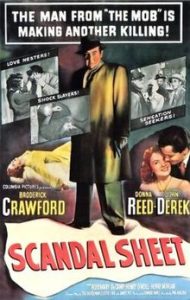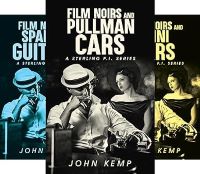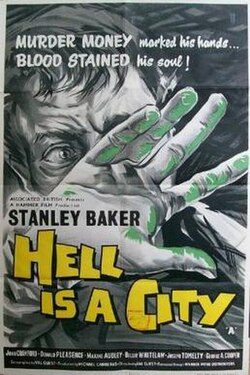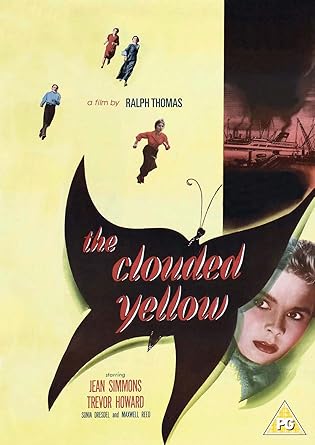
Film Noir Flashback/Tension
February 11, 2025
Film Noir Flashback/The Breaking Point
February 26, 2025I post reviews (Film Noir Flashback) of movies from, and inspired by, Hollywood’s Golden Age of Noir, the 1940s and 1950s. I am a film noir enthusiast. Maybe, like me, you are looking to enjoy films that are different, or of a different era. Films you may not have seen, ones encompassing cynical detectives, seductive femme fatales, flawed sidekicks all tossed together into intricate plots. Not forgetting the snappy dialogue too.
Backstory: Film Noir has its roots in German expressionist cinematography and American crime fiction. During the 1930s Hollywood became a perfect storm of film artists fleeing the threat of Nazi Germany, emigrating to America, and specifically to the Film studios of Hollywood. This included great directors such as Fritz Lang, Jaques Tourneur, Michael Curtiz and Robert Siodmak.
This new dramatic visual style combined with American hardboiled crime stories (noir fiction), emerged during the Great Depression and produced many classic noirs. Some of these writers include: Raymond Chandler, James M. Cain, Dashiell Hammett, Patricia Highsmith, Jim Thompson and Mickey Spillane.
I hope to showcase some of these memorable noir movies here for you. And advance apologies for a mixture of British and US English occasionally and potential spoilers, although I will always try to avoid revealing the full ending. I have applied the link below, to the Amazon.com DVD of today’s featured film.
Inspired by hardboiled detective stories and film noir, I have written the Sterling Private Investigator Series, set in present-day London. I have also posted a link to my books at the bottom of the page. For more Film Noir Flashback movie reviews: https://johnkempauthor.com/blog-film-noir-reviews/
Today’s Film Noir Flashback is:
Scandal Sheet
USA link Rent/Purchase DVD: https://amzn.to/4hYqzkI Blu-ray DVD: https://amzn.to/4gJnbc6
UK link DVD: https://amzn.to/3Qk5564 Blu-ray DVD: https://amzn.to/4k1c80M

“I read that rag of yours by accident…From axe murderer to lonely hearts…”
Film Studio: Columbia Pictures B&W/1952
Director: Phil Karson
Original Music: George Duning
Cinematography: Burnett Guffey
Film Editor: Jerome Thoms
Story: The Dark Page by Samuel Fuller
Screenplay: Eugene Ling, James Poe, Ted Sherdeman
Main Actors: Broderick Crawford, Donna reed, John Derek, Harry Morgan
Produced by: Edward Small
Run time: 82 minutes
Preview
Courtesy of Wikipedia:
Scandal Sheet is an American film noir directed by Phil Karson. The film is based on the 1944 novel The Dark Page by Samuel Fuller, who himself was a newspaper reporter before his career in film. The drama features Broderick Crawford, Donna Reed and John Derek.
Film rights to Sam Fuller’s novel were sold for $15,000 to Howard Hawks during the war. After the war, Fuller did a treatment and Sidney Buchman wrote a script, which Hawks then sold to Edward Small for $100,000. John Payne was originally offered the lead, then Dennis O’Keefe and Orson Welles were announced as stars.
Synopsis
Scandal Sheet starts with a panoramic of New York City. Immediately, we hear the wail of a police siren and the camera tracks to an overhead shot of the car, following it to an apartment complex where a murder has been committed. (“A dame murdered with a meat axe.”) Cut to Steve Mccleary (played by John Derek), who is relentlessly interviewing the sister of the victim. And wanting all of the gory details…To her disgust, she realises he is a reporter and not a police officer, “I’m not a cop, lady… All I said was I had to ask you some questions,” he says, playing the innocent. He’s hard-nosed alright.
Once the police arrive, the reporter and photographer, (a cigar chewing, Harry Morgan), head back to the offices of the New York Express. The editor, Mark Chapman (brilliantly played by Broderick Crawford), has increased newspaper profits by this sort of sensationalism journalism. McCleary is his disciple and mentee. Chapman attends a stockholder’s meeting and has to defend the charges of selling the newspaper out. “I would like to know why the New York Express, once a distinguished and respected newspaper, has been allowed to become a cheap and depraved publication,” a stockholder berates. Sounds like a familiar theme.
Note: love the timing as Chapman comes in (to the meeting) while she is in mid-sentence: “… a cheap and depraved publication…” This had to be scripted.
Chapman reminds her of the profits, “Did you like the dividend check you got last month?” he asks. “The first time in twelve years.” We see a graph on the wall displaying an upward trend of sales, backing up the editor’s overture. You can’t please all of the people…
The feature writer, Julie Allison (played by Donna Reed) is also frustrated by the newspaper’s descent into tabloid reporting. At a New York Express hosted, Lonely Hearts event, the spotlight is turned towards Mark Chapman. His estranged wife Charlotte Grant (played by Rosemary DeCamp) happens to be at the event and recognizes him (though not his name), from across the room. She approaches and says, “We’ve got a lot to talk about.” They go to her rudimentary apartment and their conversation turns bitter with Chapman aggressive and belligerent.
“When did you change your name, George, right after you left me?” she asks. “So, I wouldn’t find you?” She is right. When he abandoned her decades earlier, he changed his name and his identity, so she wouldn’t find him. “I made all of my mistakes when I was young,” he says, “and you were my biggest mistake. I fell for an attractive hunk of flesh!” he growls. “My lawyer will arrange a divorce.” In retaliation, she threatens him with exposure: “The other papers will cut you to ribbons.”
Their meeting escalates into violence between the two. First, Mrs Grant hits him in the face but when he pushes her back, she falls to the floor. About to leave, he realises she is unmoving. He now notices the metal pipe and pipe nut that he has shoved her head against. She is dead… He moves the body to the bathtub, making it look like an accident, removing a Lonely Hearts pin (or most of it) from her coat, the ring from her finger and wiping away any fingerprints. He also removes a claim ticket for “Pete’s Hock Shop” from her purse. What could she have left there?
After the discovery of the crime, McCleary goes to the crime scene and snoops about the apartment, alongside the police.
I’m surprised reporters and police (perhaps begrudgingly) once worked side by side in this way. But here is a link to Arthur Fellig (“Weegee” as he was known), a New York photographer and photojournalist in the 1930s and 1940s: https://en.wikipedia.org/wiki/Weegee
Poking about, as the detectives go about their business, McCleary sees a coat in the open wardrobe. The coat belongs to the deceased and was worn to the recent event. Looking closer, he sees the remnants of a pin on the lapel. McCleary removes the pin, and pockets it. This guy should be heading the investigation!
McCleary excitedly goes to his editor and suggests it was a murder and not an accidental death. Chapman does not want to invite suspicion upon himself, so, fakes enthusiasm to run the story, calling it the Lonely Hearts Killer.
Chapman removes that claim ticket from his wallet and goes in search of “Pete’s Hock Shop”. Proceeding to the store, he sees two cops inside, so abandons his mission. He then runs into Charlie Barnes (played by Henry O’Neil) who he knows; now an alcoholic but a former newspaper reporter; and the winner of a Pulitzer prize.
Barnes shrewdly surmises that Chapman is working the case. To get rid of Barnes, Chapman gives him some money (and in turn, mistakenly the ticket as it is mixed in with the dollar bills). Finding this, Barnes visits the hock shop and produces the claim ticket (not knowing what it is for…). Once he opens it, he realises he has hit the (journalism) jackpot again.
Inside, are wedding photographs of Chapman (formerly George Grant) and his now-dead wife. The former reporter recognizes them both and realizes that Mark Chapman must be the murderer. Barnes calls Alisson with the intention of sharing his findings and give her the “scoop”. Though, McCleary interjects and tells Allison that Barnes is wasting her time. She hangs up. Chapman is aware of the conversation and stalks Barnes, and ultimately, he kills him.
McCleary finds the suitcase of the deceased. He shows Chapman a photo of the married couple (although the groom is only in profile). Chapman (anxiously) publishes the photo in the next edition, and is much relieved when no one comes forward. McCleary goes to see Julie Allisson (who is fed up and planning to hand in her resignation). McCleary convinces her he has changed, and that he is seeking retribution for Charlie Barnes’ murder. He persuades her to go with him to Connecticut to find the preacher (or judge) who married the couple many years ago. Will Chapman have to kill him too?
Of course, Chapman doesn’t want McCleary to go, and says he wants the story to, “die a natural death”. McCleary, however, has other ideas…
Things to like
*The “circulation-o-meter”. When the newspaper sales increase, we see an anonymous hand pushing the needle north!
*Old-time newsrooms. We get to see the heartbeat of the operation; the newsroom (or at least a mock-up of one). First and second editions, rotary dial telephones (Western Electric here), notepads and pencils (not a hint of a computer yet, of course), typewriters, linotype operators and rolling presses. Visually, this is more eye-catching and more interesting than a modern office. And naturally enough, everyone smokes!
*After Mark Chapman murders his wife, we are decidedly in Alfred Hitchcock territory, the master of suspense. We watch on as Chapman contemplates his situation. Not for a second, though, do we believe he will report it to the police and plead involuntary manslaughter. No, he sinisterly creeps about the apartment, moving the body, wiping fingerprints off the door handle, and removing personal items that might connect him to the victim. Finally, outside in the dusky night illuminated by a streetlight, he drops her wedding ring through the grill of a storm drain.
*The back-and-forth quips between McCleary and Allison are a delight. Julie Allison is uncompromising. She holds her own, staying true to her principles and ethics, while McCleary is driven and unscrupulous. She stays around for as long as she can stomach it.
* Broderick Crawford’s performance. See below.
Quotes
Steve McCleary: “Why don’t you simmer down now. You’re not so pretty when your feathers are all ruffled.”
Julie Allison: “Don’t Steve, I’m in no mood for levity.”
Steve McCleary: “Do you feel like dancing?”
Julie Allison: “Do you think that will smooth my feathers?”
***
Mark Chapman: “What do you want?”
Office Runner: (entering the Editor’s office) “Mr Maddison called down from the boardroom again Mr Chapman.”
Mark Chapman: (on the phone to McCleary) “Did you hear that? I’m letting them stew in their financial juices.”
***
Mark Chapman: (pointing to the lowest trendline on the sales graph) “Here’s where I took over your highly respected white elephant.”
***
Julie Allison: (to Mark Chapman) “…This whole wild west show is ridiculous and I want no part of it!”
***
Charlotte Grant: “The years have been kinder to you. What is it? Nineteen, twenty…I used to keep track….”
Mark Chapman: “What’s the difference. Now that you found me, what do you want?”
***
Julie Allison: (referring to her colleague, Steve McCleary) “Mom, you think it’s safe for me to travel out of state at night with this young man?”
Mrs Allison: “Just so he doesn’t misconstrue the meaning of ‘freedom of the press’.”
Must-see scene
There are a few scenes and instances whereby Mark Chapman shifts uncomfortably in his seat. One time, his young reporter comes into Chapman’s office with updates regarding the murder of his estranged wife. Another time involves the discovery of a suitcase which McCleary sets down upon his desk.
All are great scenes which show Broderick Crawford’s stagecraft. The editor in-chief paces, fidgets, and sweats. And thinks. As if a chess player, you watch him as he works out his next move, to remain one step ahead of the sleuthing McCleary.
McCleary produces the torn off pin from the coat of the deceased, suggesting she had attended the Lonely Hearts event. Chapman is stunned. It seems his protégée’s bloodhound instincts are making his editor more than nervous. In fact, he is spooked and later, starts sweating heavily.
Feigning to be excited by the scoop, the editor-in-chief calls in some of his staff. McCleary lays it out for them: “We’ll call her Miss Lonely hearts.” McCleary goes on to animatedly hypothesize how the murder was executed. “He lugged her to the bathroom. Stripped and tossed the body into the tub… No, no, he stood the body in the tub, aimed, let go, bang! Her head cracks against the faucet…”
McCleary tells them she was married… Again, Chapman is surprised at to how he might know this. “A mark on her ring finger,” he says. “It was removed.”
Chapman has taught McCleary everything he knows, and now it’s coming back to haunt him…
Summary
A fully absorbing film that showcases Broderick Crawford’s talents, ably backed up by Donna Reed. Both give outstanding performances. The film is lean and taut and moves along at a good pace and with great style too. The spiralling descent of the protagonist is engrossing and uncomfortable which makes Scandal Sheet so watchable as we see the mask slip.
Many other things to enjoy too; the peripheral characters; the gallows humour and black and white New York. All add up to a recommended trip back in time to 1952, and this noir world of the tabloid press. Highly recommended.
For more Film Noir Flashback movie reviews: https://johnkempauthor.com/blog-film-noir-reviews/

USA Link: Film Noirs & Mini Bars (paperback): https://amzn.to/3CQ66zv (eBook): https://amzn.to/4kdryiX
UK Link: Film Noirs & Mini Bars (paperback): https://amzn.to/3QiRFXW (eBook): https://amzn.to/4hEwDPi




